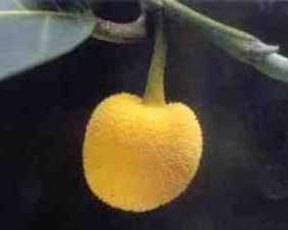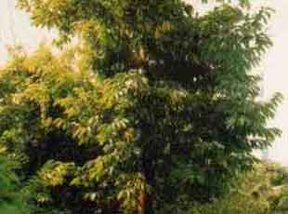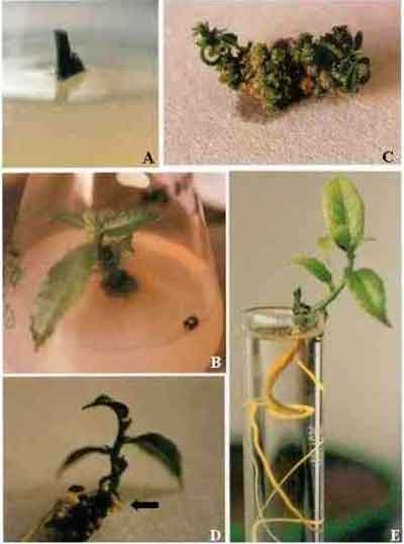From Trends in New Crops and New Uses, Proceedings of the fifth National Symposium
by Nirmal Joshee, D. R. Bastola, V. P. Agrawal, and A .K. Yadav
Lakoocha: A Multipurpose Tree of Warm Climate
Introduction
Artocarpus lakoocha
Roxb., Moraceae, is a valuable tropical tree species native to India
and used for fruit, furniture, timber, and feed. The lakoocha fruits
are generally eaten fresh. Each fruit contains 20–30 seeds that are
fleshy with thin seed coat. The edible fruit pulp is believed to act as
a tonic for the liver. Raw fruits and male flower spike (acidic and
astringent) are utilized in pickles and chutney (sauce). The lakoocha
tree is also valued for feed and timber. The hardwood sold as lakuch,
is comparable to famous teak wood. Lakuch which is durable outdoors as
well as under water, is used for construction, furniture, boat making,
and cabinet work. Tree bark containing 8.5% tannin is chewed like betel
nut, and is also used to treat skin ailments. It yields a durable fiber
good for cordage. The wood and roots yield a lavish color dye. Lakoocha
seeds and milky latex are purgative. Seeds contain artocarpins (ALA I
and ALA II), the isolectins which exhibit high haemagglutination
activity (Wongkham 1995). However, the agglutinin (ALA) from Artocarpus lakoocha
is not organ specific. Moreover, the haemagglutination activity of ALA
was demonstrated in various organs of the plant except fruit flesh. The
highest and the lowest activities were found in the seeds (14,400
units/g fwt) and leaves (5 units/g fwt), respectively.
Botany and Distribution
The genus Artocarpus, Moraceae, which consists of jackfruit (Artocarpus heterophyllus), lakoocha or monkey jack (A. lakoocha), chempedak (A. integer), breadfruit or breadnut (A. altilis), and marang (A. odoratissima),
comprises over 50 distinct species of monoecious evergreen trees (Drew
1997). Compound fruits are derived from swollen flower heads. Artocarpus
species display high levels of genetic variability, both between and
within species. This is evident from the wide range of locally
distributed Artocarpus
genotypes. Breadfruit cultivars are triploid and seedless. Lakoocha
seedling trees take five years to come into bearing. The orange-yellow
male flowers and reddish female flowers of lakoocha are borne
separately on the same trees. Fruits are nearly round or irregular,
from 5 to 12 cm in diameter and have a velvety surface (Fig. 1). The
lakoocha fruits are dull-yellow with pink tinge and sweet-sour pulp.
Fruit yield can be up to 80 kg/tree with fruit weight ranging from 200
to 350 g.

Fig. 1. A developing fruit (60%) of Artocarpus lakoocha.
The
lakoocha is popularly known as “monkey jack” or “lakuchi” in India,
“badahar” in Nepal, “tampang” in Malaya, and “lokhat” in Thailand. A
native of the humid sub-Himalayan regions of India, it grows up to
1,200 m altitude. The lakoocha trees grow 6 to 9 m tall with large,
leathery and deciduous leaves (Fig. 2).

Fig. 2. A mature tree of Artocarpus lakoocha.
Propagation
There
are a number of Important problems associated with regeneration and
propagation of lakoocha: (1) tree population of lakoocha is gradually
decreasing due to poor seed viability and extensive exploitation for
food, timber, and other uses; (2) seeds, once extracted from the fruit,
quickly loose viability within a week, or sometimes even in few days;
and (3) vegetative propagation methods such as rooting of hardwood or
softwood stem cuttings have not been successful (Napier and Robbins
1989).
Protocols were developed for micropropagation of lakoocha
seedlings. Lakoocha fruits were collected just before maturity and
stored at 4°C. Fruits were washed under running tap water for 1 hr,
then washed with detergent and rinsed 3 times with sterile distilled
water. Fruits were dipped in 70% ethanol for 1 min, air dried and
flamed to evaporate ethanol. Following this, fruits were cut open to
remove seeds. Air dried seeds were germinated on sterile sand and
slanted agar in test tubes. Germination medium contained 0.8% agar and
0.5% sucrose with pH adjusted to 5.7–5.8. Six-week-old seedlings were
utilized to prepare leaf disc, nodal segment, and shoot tip explants.
Aseptic
cultures using leaf discs, nodal segments and shoot tip explants were
initiated on MS basal medium containing NAA and BA alone and in
combination along with a control without growth regulators. Leaf discs
did not show any response in different media. Nodal and shoot tip
explants (Figs. 3A, C) initiated calli at cut ends. Shoot tips were
more responsive and highly prolific in initiating shoot buds. Optimum
results for multiple shoot induction were obtained with MS supplemented
with 1.0 to 2.0 mg L-1 BA. Rooting was observed in 2 to 3 weeks in MS
medium supplemented with 2.0 mg L-1 IBA (Fig. 3D).
 | Fig.
3. Sequential stages in the complete in vitro regeneration of
lakoocha plantlets. A. Nodal explant. B. Elongation of axillary
bud in nodal explant. C. Shoot tip producing callus and numerous shoot
bud primordia. D. Elongated shoots initiate rooting in the induction
medium, arrow points to a root. E. Complete plantlet developed with
well defined shoot and root at the end of 4–5 months in culture.
|
Conclusions
In
vitro micropropagation protocol for rapid multiplication of lakoocha is
required to maintain an adequate supply of plants to establish new
plantations and to conserve desirable genotypes. It is also considered
important to develop somatic embryogenesis protocols for in vitro
regeneration to enhance genetic improvement of desirable lakoocha
genotypes.
References
Drew,
R.A. 1997. The application of biotechnology to the conservation and
improvement of tropical and subtropical fruit species. FAO, Rome p.
1–77.
Napier, I. and M. Robbins. 1989. Forest seeds and nursery practice in Nepal. p. 94–95.
Wongkham, S. 1995. Isolectins from seeds of Artocarpus lakoocha. Phytochemistry 40:1331–1334.
|
|


